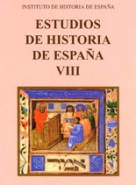El matrimonio clandestino en el siglo XVII: entre el amor, las conveniencias y el discurso tridentino
Keywords:
Council of Trent, Moral Literature, Catechisms, Clandestine Marriages, XVII Century, Love Marriages, Social StrategiesAbstract
The Council of Trent —Tametsi decree— following the position started in the IV Letran Council, declared invalid clandestine marriages, undertaken out of the church, without the required publicity, presence of the parish priest or witnesses; regulation that would take some time to be accepted by the marriages of the time. In the baroque Seville, clandestine marriages persisted, either as a representation of love unions without the parents consent, or as a strategy for social promotion used by families of lower condition.Downloads
Downloads
Published
02/22/2017
How to Cite
Candau Chacón, M. L. (2017). El matrimonio clandestino en el siglo XVII: entre el amor, las conveniencias y el discurso tridentino. Estudios De Historia De España, 8, 175–202. Retrieved from http://200.16.86.39/index.php/EHE/article/view/351
Issue
Section
Artículos
License






























 Estudios de Historia de España
Estudios de Historia de España